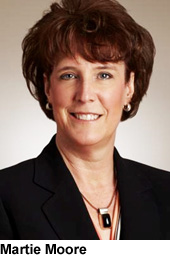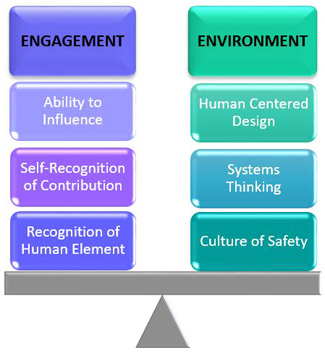Creating trust requires a multifocused strategy.

Through research and personal experience, the author has found that quality and safety, built on trustworthy actions by all team members, strengthen an organization.
 Pause a moment and reflect on this statement: “Trust is an outcome.” An outcome is defined as “the way a thing turns out; a consequence.” Trust, then, is a result of something or someone doing an action or actions that bring about a consequence. We regard actions that generate trust as trustworthy.
Pause a moment and reflect on this statement: “Trust is an outcome.” An outcome is defined as “the way a thing turns out; a consequence.” Trust, then, is a result of something or someone doing an action or actions that bring about a consequence. We regard actions that generate trust as trustworthy.
Value metrics must be set and validated before trust can be achieved and actions can be deemed trustworthy. Value metrics are not the same for everyone. Personal experiences uniquely influence our ability to trust. Metrics of trustworthiness are never clearly defined; they constantly change and inform culture. That’s the challenge of transforming our workplaces.
Feels like yesterday
Think of a time when you found yourself in a work situation you knew was wrong. You struggled with whether or not to say something. You didn’t want to create waves. You didn’t want to be singled out. You felt marginalized, and when you thought about it, you became angry. I have had just that experience. It was early in my career but feels like it was yesterday.
I worked for a faith-based hospital that, six months earlier, had merged with a community hospital. Many of the community hospital’s NICU staff had quit because of the merger. I was assigned to work on that unit because of my experience in pediatrics.
When I walked into the NICU, I was met with hostility. One of the first tasks I was asked to do was check the code cart to assure quality control and integrity of the emergency equipment. I am not sure why, but I felt I was being set up by the charge nurse. I paid close attention to the details of the code check sheet and what I was seeing in the code cart. Items were missing. I replaced them but also filed a notice with the manager that quality controls were not in place for the emergency equipment. In fact, I was so bold as to say: “You can’t trust the code cart to be ready. You can’t trust the NICU staff!”
Later, the charge nurse pulled me into the nurse manager’s office. She said this was part of normal orientation practice. But unspoken, embedded in her words, was the message that this was about improper behavior—mine. What the nurse manager missed was that the real issue wasn’t about an orientation process but, instead, was about power and control by the charge nurse. Lost in the middle of this human dynamic was safety for all—patients, families, and the care team.
After that experience, I had no trust in the unit’s leadership and requested to go back to my former unit. When I met with the chief nursing officer to discuss what had happened, she said she had hoped I could make a difference in the NICU’s culture. I remember thinking, “One person cannot change such dysfunction!”
The power of one
I was wrong. One person can change the culture of a workplace. One person can influence trustworthy decisions and actions. Now, as a chief nursing officer, it is my passion to create healthy work environments. Through research and personal experience, I have learned that quality and safety, built on trustworthy actions by all team members, strengthen an organization. As Nan Russell, writing in a Psychology Today blog, observes, “Gaining awareness about our actions and whether they build or diminish trust is an essential skill in a work-world where trust has become the new currency.”
Creating trustworthy work environments requires a multifocused strategy. Influencers can twist and shift the human response, which influences the work environment. Worker engagement is highly affected by organizational power shifts, demands of individual discretionary energy, and resiliency—as well as intrinsic and extrinsic pressures. The following model illustrates the balance that must be achieved and sustained to transform a workplace into a culturally healthy environment.

Two key components on the environment side of the model are human-centered design and systems thinking. Human-centered design develops solutions, tools, and products from the human perspective. When people engage in designing their own environments and the tools they use, their collective brilliance results in better environments and more intuitive products. When tools are intuitive for the user, the work is easier.
Systems thinking is needed to understand how various elements within a system influence one another. Recognizing how each component contributes to the greater whole helps advance feelings not only of team membership but also a sense of community.
Initially, I utilized the model to guide and refine my strategic plan and goals for the organization I was leading. But I felt something was missing with regard to the healthcare delivery system. That’s when I started to explore the role that human-centered design plays in product development.
What if?
Historically, clinical practice has largely adapted to available tools and products. Using a product in a manner for which it wasn’t designed is proudly labeled a “workaround.” Industrial engineers look for workarounds as indicators of places within a system where there is opportunity for improvement. Or put another way, workarounds point to places in a healthcare system where clinical providers experience frustration.
What if workarounds weren’t needed? What if the work environment was trustworthy? What if products and tools were designed for how the user thinks and practices? What if knowledge gained from evidence-based practice was reflected in how tools and products are designed? What if we thought about creating trustworthy processes and systems that direct our energy toward who matters most—those we serve and care for?
I have learned that one person can make a difference. It’s the same person who stares back at you in the mirror every day. It’s you! Each one of us, drawing upon our experiences and observations, needs to think about and study how to improve the places we touch in the healthcare delivery system. When we apply what we learn, the system improves. When each of us asks “What if?” and is unwilling to accept the standard answers, the system improves.
Culture is defined by what we say and do each day. A healthy culture with trust as an outcome is defined in the same way. RNL
Martie L. Moore, MAOM, RN, CPHQ, is chief nursing officer at Medline Industries, Inc. in Northfield, Illinois, USA. Moore serves as a corporate advisory council member for both the National Pressure Ulcer Advisory Board and American Nurses Association. She is also on the dean’s advisory board for the University of Central Florida College of Nursing.
Editor’s note: Martie Moore facilitated the closing plenary panel session, Foundations for Best Practices in Healthy Work Environments, on Sunday, 24 February 2019, at Sigma’s Creating Healthy Work Environments conference in New Orleans, Louisiana, USA. Panelists were Rose Sherman, Beth Ulrich, Dorrie Fontaine, and Ivette Roldan.